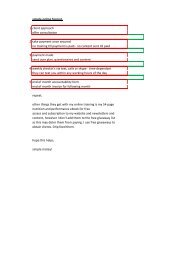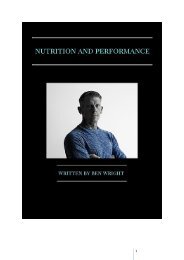You also want an ePaper? Increase the reach of your titles
YUMPU automatically turns print PDFs into web optimized ePapers that Google loves.
Whey protein - This is great if you need it to top up protein stores before or after workouts. Or if you<br />
have a job that means you may not have access to whole foods all day long for example.<br />
Supplements can benefit people with illnesses <strong>and</strong> intolerances or maybe for those who just need to<br />
get the calories in each day to hit targets.<br />
So, what is whey? Whey is protein which is made up of amino acids from dairy. The problem is,<br />
some companies will try to save money by ramming all sorts on non-essential elements into it. The<br />
term “amino spiking” or “nitrogen spiking “is being used. This means companies will spike the<br />
protein with free form amino acids (low quality & inexpensive) to increase the overall dietary protein<br />
content of the powder. They do this without disclosing it to the consumer. Highly illegal. So, when<br />
purchasing whey, we must have some sort of idea about what essential amino acids are in the<br />
powder. If the scoop is 100g <strong>and</strong> the whey content is 45g then ask yourself what else makes up the<br />
remaining 55g? They may put things like Creatine, BCAA’s, Glutamine, bulkers, carbs for mass<br />
gainers etc. etc. into the whey. So, all I can advise is that you take the time to read the ingredients<br />
<strong>and</strong> make sure it is as healthy as possible. Also, make sure it is as natural as possible <strong>and</strong> contains<br />
what you are specifically looking for.<br />
The ingredients list on the back will have everything listed in order of product volume. What you’re<br />
buying should be at the top with the rest of the ingredients in descending order of importance.<br />
Whey is fast acting so works great just before/after a training session. Due to it being in <strong>and</strong> out of<br />
the system quickly we cannot rely on it for consistent time consuming periods of amino distribution.<br />
A serving of 35 – 40g works best in <strong>and</strong> around training.<br />
There are three types of whey:<br />
<br />
<br />
<br />
Concentrate: This contains lower levels of fat <strong>and</strong> carbohydrates (lactose). The percentage of<br />
protein in a concentrate is dependent on how concentrated it is. This could be as low as 30%<br />
to as high as 90% depending on the br<strong>and</strong> <strong>and</strong> the company. Concentrate is usually tastier<br />
<strong>and</strong> if the amino profile is good then worth buying. Buy quality protein.<br />
Isolate: Isolate is processed even further to remove even higher levels of fat <strong>and</strong> lactose. It’s<br />
generally a little more expensive but usually healthier <strong>and</strong> more potent.<br />
Hydrolysate: This type of protein is said to be pre-digested allowing the body to absorb it<br />
more effectively. Its more expensive but not necessarily much more beneficial than the rest.<br />
Here is a list of the essential amino acids you want to see on the profile list *Essential because the<br />
body can’t make them freely.<br />
Amino acid (makes up protein) Mg per body weight in KG<br />
H histidine 10<br />
I Isoleucine 20<br />
L Leucine 39<br />
K Lysine 30<br />
M Methionine + cysteine 15<br />
F Phenylalanine + tyrosine 25<br />
T Threonine 15<br />
W Tryptophan 4<br />
V Valine 26<br />
To figure out how much you would need daily just multiply your bodyweight in KG by the MG per<br />
amino acid.<br />
33




